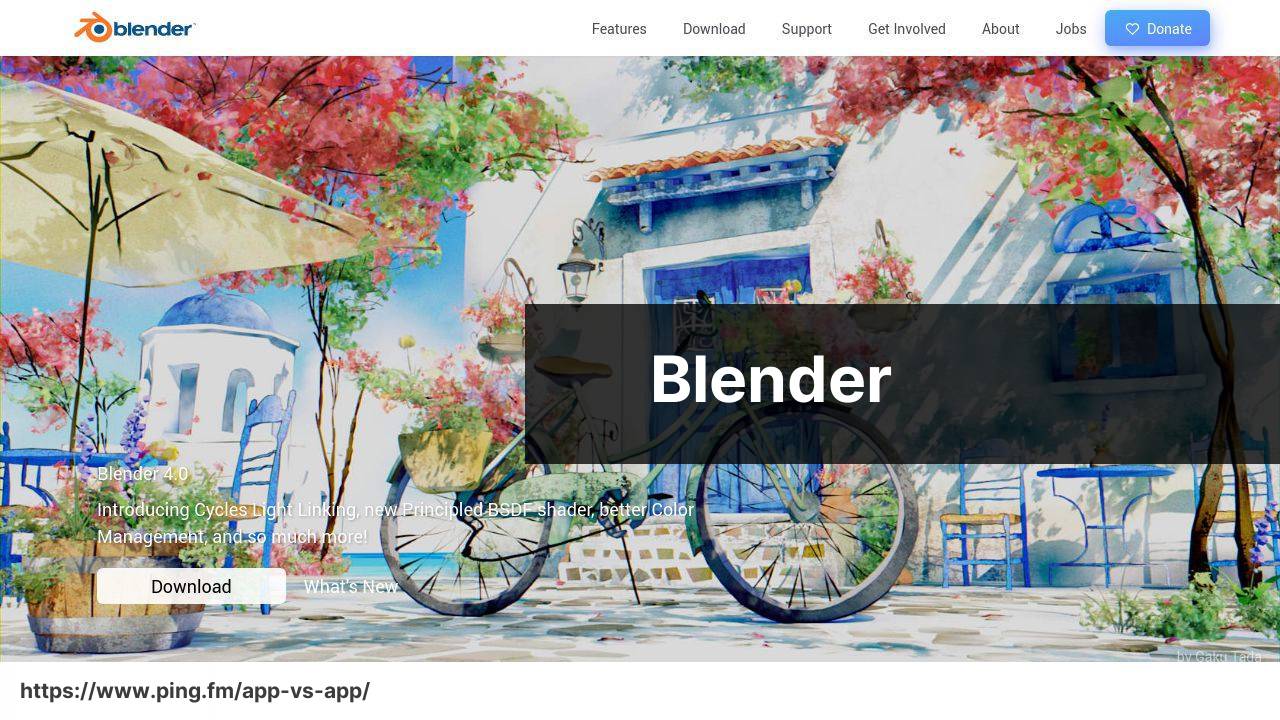Compare | Winner | |
| Cost | ||
| Learning curve | ||
| User Interface | ||
| Modeling Features | ||
| Rendering | ||
| Animation | ||
| Texturing | ||
| Interoperability | ||
| Community and support | ||
| Platform Availability | ||
| FREE / PAID | Blender is completely free. This includes both personal and commercial use. They offer optional donations for users to support their development. | AutoCAD operates on a subscription basis. Their standard monthly plan costs $210, but they offer yearly plans at a significant discount. |
| Conclusion | 🎉 Blender stands out for its comprehensive feature set, competitive output quality 🎨, and freedom 🦅 – it’s free! But its complex interface can be intimidating for beginners 😵. | 👍 AutoCAD is a robust professional tool used widely in architecture and engineering. Feature-rich, 😕 but it comes with a high price tag 💰 and has a steep learning curve ⛰️. |
Blender Pros & Cons
💯 Free and open-source software
💪 Comprehensive feature set for modeling, animation, rendering, and more
🎨 Competitive in terms of output quality
👥 Large and active community
📹 Excellent for creating animated movies and advanced 3D models
AutoCAD Pros & Cons
🎯 Precise and professional-grade software
🏗️ Highly used in architecture and engineering
✍️ Extensive drawing and annotation capabilities
🌐 Good interoperability with other Autodesk tools
🚀 Advanced 3D modeling and rendering options
🎓 Numerous resources and community support
⛔ Complex for beginners
💼 Less professional support compared to commercial alternatives
🧮 Less precision compared to CAD software
🤹♂️ Large scope can be overwhelming
🎛️ Interface can be intimidating
🖌️ Texturing tools can be a bit lacking
💰 High cost
🎢 Steep learning curve
🧐 Too complex for beginners
🔌 Limited plugin library
🤔 Interface can be overwhelming
Other best 3d modeling software
💡 SketchUp is a friendly choice for beginners, known for its ease of use 🎈 and quick modeling capabilities 🚀. However, it lacks some advanced features compared to leaders 🚧.
🌟 Maya is a high-end tool preferred by professionals, especially in the movie 🎥 and game 🎮 industry. It’s powerful but expensive 💸 and it requires a strong background in 3D modeling ❗.
💼 3ds Max bridges the gap between usability and power, making it popular in the architectural visualization industry 🏗️. Yet, it’s costly and may require extensive learning 📚.
FAQ
What are some top-quality software tools for 3D modeling?
The leading software platforms for 3D modeling include AutoCAD, Blender, Maya, 3DS Max, and SketchUp. These tools are employed widely by professionals for creating 3D visualizations, animations, and virtual reality experiences.
Could you tell me what exactly is AutoCAD?
AutoCAD is a computer-aided design (CAD) software developed by Autodesk. It is primarily used by architects, project managers, and engineers for precise 2D and 3D drafting and modeling. More about AutoCAD can be found on the official Autodesk website.
Why is Blender popular for 3D modeling?
Blender is favored by many for its versatility. Not only does it support 3D modeling, it also provides comprehensive functionality for animation, rendering, post-production, creation of interactive 3D applications, and more. Best of all, Blender is an open-source tool, making it free for everyone to use.
Is AutoCAD exclusively for professional use?
Though primarily utilized by professionals, AutoCAD is also beneficial for students and hobbyists looking to familiarize themselves with architectural drafting and 3D modeling.
How does Blender differentiate itself from other 3D modeling software?
Blender differentiates itself by being a comprehensive, free, and open-source 3D creation suite. It supports a vast array of features from modeling, rigging, animation, simulation, rendering, compositing, and motion tracking to video editing and 2D animation.
What type of jobs necessitate knowledge of AutoCAD?
Jobs that often require knowledge in AutoCAD include positions in architecture, engineering, project management, graphic design, city planning, and construction.
As a beginner, would I face a steep learning curve with Blender?
Although Blender is incredibly versatile and powerful, it does come with a steeper learning curve for beginners compared to other tools. But, with consistent practice and access to readily available tutorials online, it’s manageable.
Can AutoCAD also be used for 3D printing?
Yes, AutoCAD is often employed in 3D printing. It can create detailed 3D models which can be exported in STL format, which is the standard file type for 3D printing.
Which software between Blender and AutoCAD is more suitable for animation?
In terms of animation, Blender would be the more suitable choice. While AutoCAD provides basic animation capabilities, Blender has robust tools for character rigging, animation layering, morphing, and more.
Does AutoCAD provide any functionality for project collaboration?
Indeed, AutoCAD provides extensive features for team collaboration. Team members can share access to drawings and revisions, and use live linking to Microsoft Excel spreadsheets, as well as other collaborative features.
Does Blender offer integration with other software?
Blender provides integration with a variety of other software, offering support for various file formats, and it’s compatible with Python scripting for more advanced customization and automation.
Can AutoCAD be used for creating video games?
AutoCAD isn’t generally used for creating video games. Although it can create 3D models, it lacks comprehensive tools for game development. Software like Unity or Unreal Engine are more suitable for that purpose.
What kind of support and learning resources are available for Blender users?
Blender has a strong community offering numerous tutorials, guides, and forums. One can start with the tutorials available on the official Blender website. Furthermore, platforms like YouTube and Udemy have extensive resources.
What file formats does AutoCAD support?
AutoCAD supports numerous file formats including, but not limited to, DWG, DXF, DWT, DXB, STL, and PDF. You can find a comprehensive list on the official Autodesk website.
What is the physics engine used in Blender?
Blender uses the Bullet Physics Engine for simulation of rigid body dynamics, soft body dynamics, and collision detection.
Is there a mobile version available for AutoCAD?
Yes, AutoCAD provides a mobile app, AutoCAD Mobile, which is available for iOS, Android, and Windows devices. This allows users to view, create, edit, and share CAD drawings wherever they are.
Are there camera and light simulations available in Blender?
Blender certainly has in-depth camera and light simulations. It also features physics-based rendering and realistic materials to create visually captivating scenes.
Is AutoCAD compatible with both Windows and Mac?
Yes, AutoCAD is compatible with both Windows and Mac operating systems. There’s also an app available for mobile devices, allowing users to work on their projects from virtually anywhere.
Does Blender support VR rendering?
Yes, Blender does support VR rendering. Using Blender’s VR scene inspection feature, one can fully evaluate and immerse themselves in the created 3D environment.
Can I create 2D drawings in AutoCAD?
Yes, AutoCAD is well-known for its ability to create detailed 2D drawings which include blueprints, floor plans, and architectural designs, among others.
What differentiates Blender from other 3D modeling software?
Blender stands out because of its comprehensive set of tools useful for creating 3D models, animations, games, and visual effects. Additionally, Blender is an open-source tool, allowing anyone to use and modify it for free, unlike most 3D modeling software like AutoCAD.
Could you share any reliable resources for learning Blender?
Certainly, a very useful resources for learning Blender is the official Blender Manual. Additionally, Blender Guru features comprehensive tutorials for beginners and intermediate users.
What industries commonly use AutoCAD for 3D modeling?
AutoCAD is widely utilized in various industries including architecture, engineering, construction, mechanical and even the film industry for 3D design, drafting, modeling and rendering.
How does the cost of AutoCAD compare to other 3D modeling software?
The cost of AutoCAD can be considerably higher compared to other 3D modeling software, especially since it offers both standard and specialized toolsets. Prices also vary based on licensing options. For the most current pricing options, be sure to check out the official AutoCAD pricing page.
What are the popular alternatives to AutoCAD and Blender for 3D modeling?
Some popular alternatives to AutoCAD and Blender include 3D modeling software such as SketchUp, 3DS Max, Rhino, and SolidWorks.
Is it possible to use Blender for commercial purposes?
Yes, since Blender is open source, it can be used for both personal and commercial projects without any licensing fee.
Does AutoCAD provide support for 3D printing?
Yes, AutoCAD supports 3D printing. Models created in AutoCAD can be exported in formats compatible with 3D printers.
What file formats does Blender support for 3D models?
In addition to its native file format (.blend), Blender also supports a variety of 3D file formats such as .obj, .fbx, .3ds, and .stl, making Blender widely compatible with many 3D modeling applications.
Does AutoCAD support scripting or automation?
Yes, AutoCAD provides a feature called AutoLISP, a scripting language that allows users to automate and customize AutoCAD to suit their individual needs.
Is it possible to create animations in Blender?
Yes, Blender is well known for its powerful animation tools. It includes a range of features for rigging, animating, simulating, rendering and compositing for creating animations.
What operating systems are compatible with AutoCAD?
AutoCAD is compatible with both Windows and MacOS. Autodesk, the company behind AutoCAD, also provides a web and mobile app version called AutoCAD 360.
Can Blender be used on Mac computers?
Yes, Blender is designed to be multi-platform and can be run on MacOS, Windows, and Linux systems. You can download the appropriate version from the official Blender download page.
Are there any tutorials on how to get started with 3D modeling in AutoCAD?
Yes, Autodesk provides a series of short tutorials for beginners to learn the basics of 3D modeling in AutoCAD.
Is Blender suitable for game development?
Definitely, Blender comes equipped with an integrated game engine which allows for game development. Additional game assets, interactive 3D applications, and simulations can all be created within Blender.
Do I need any specific hardware for running AutoCAD?
Yes, since AutoCAD is a resource-intensive software, Autodesk specifies certain system requirements for optimal performance of the software. Users are recommended to have a high-performance graphics card, ample memory, and a capable processor. You can check the detailed system requirements on their official site.
Can I edit video in Blender?
Yes, in addition to 3D modeling and animation, Blender also includes a full-featured video editing suite. The Video Sequence Editor (VSE) in Blender enables cutting and splicing of videos, adjustment of layers and filters, as well as other common tasks.
What are the different types of 3D Modeling that can be done using AutoCAD?
AutoCAD offers two main types of 3D modeling – solid modeling and surface modeling. Solid modeling is used for making 3D designs while surface modeling is used for creating 3D surfaces. These techniques can be applied across various industries for design and visualization purposes.
Can Blender be used for architectural visualization?
Yes, Blender can be effectively used for architectural visualization. With its ability to model complex structures, apply textures, and generate photorealistic renders, it is a popular choice for architectural visualization among many professionals.
Does AutoCAD offer any rendering options?
Yes, AutoCAD provides several rendering options that users can use to create photorealistic images. The software includes a rendering engine that allows you to modify lighting, shadows, and reflectance to create high-quality visualizations.
What are some of the unique features of Blender?
Blender boasts many unique features, including advanced sculpting tools and brushes, retopology tools, comprehensive array of modeling tools, CPU and GPU rendering, simulation tools for soft body, rigid body, fluids, cloth, particles and smoke, and even a built-in compositor for post-production work. These features make Blender very versatile for various 3D projects.
 ping.fm
ping.fm 

